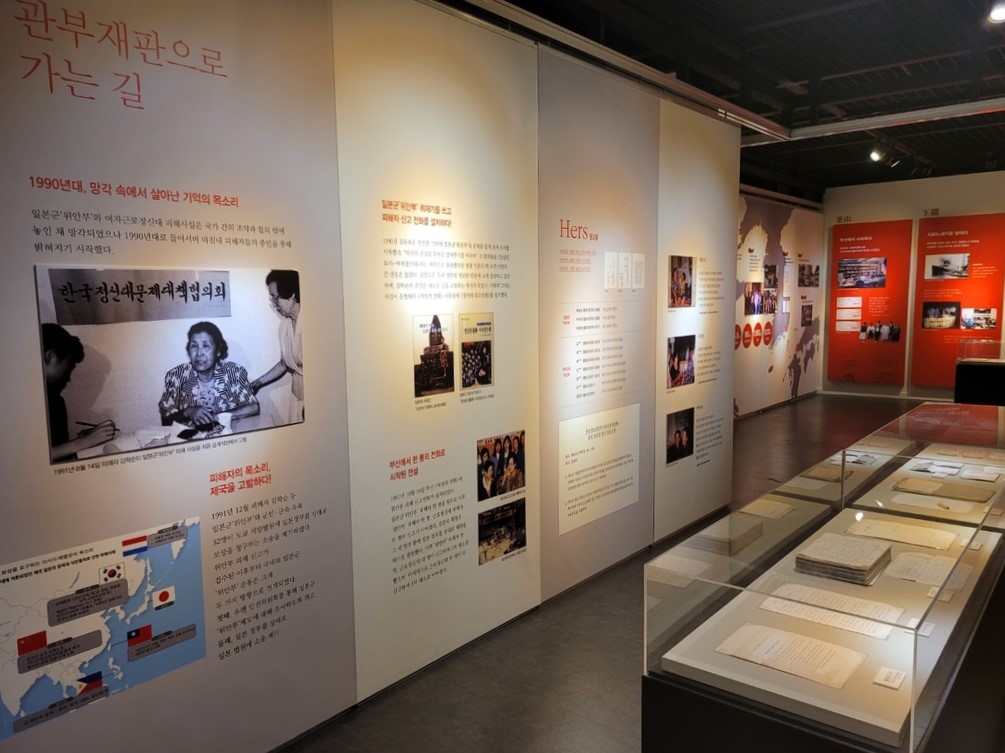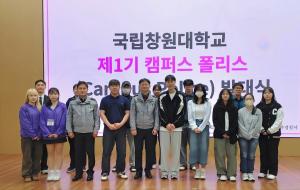 |
| ▲ A part of the Shimonoseki Trial and the Unended Herstory Exhibition (Source: Yonhap News) |
On February 15, a special exhibition, "Shimonoseki Trial and the Unended Herstory," opened at the Jo Hyeon- uk Art Hall located inside CWNU Museum. The exhibition focused on the life of the late Kim Mun- suk, a female activist who dealt with the movie, "Herstory." CWNU museum director Hong Seung- hyeon and Sustainable Development Center director Mun Gyeong- hui, provided an opportunity to ruminate on the meaning of the Shimonoseki Trial, which was the only one recognized by the Japanese judiciary.
"The Shimonoseki Trial and the Unended Herstory," is an exhibition that thinks of clues to resolve, "Comfort Women," issues by shedding light on, The Shimonoseki Trial, which has been joined by Korean and Japanese citizens, by deviating from the conventional view of the Japanese Military’s, "Comfort Women." The Shimonoseki Trial was a lawsuit in which three victims of the, "Comfort Women," and seven victims of the Korean Women's Volunteer Labour Corps, went and returned between Busan, Korea, and Shimonoseki, Japan, from 1992 to 1998, to claim an apology and compensation from the Japanese government. "Comfort Women," means Korean female victims who were forcibly mobilized to military comfort facilities during Japan's Sino- Japanese War and the Pacific War through job fraud, kidnapping, the threat of the government with state power, and human trafficking to solve Japanese sexual desires. The, "Comfort Women," victims demanded a sincere apology from the Japanese government and legal indemnification for damage. However, Japan didn’t fully reflect the wishes of the victims and progressed with the, "2015 Korea- Japan Comfort Women Victims' Agreement," which ended in a government- to- government exchange of pending issues.
The person who led the Shimonoseki Trial to partial winning was Kim Mun- suk, a women's activist and the Chairman of the Board of the Busan Council for Women Drafted for Military Comfort Women by Japan. When Kim Mun- suk was over 60, she incidentally heard of the, "Comfort Women," issue. Chairman Kim Mun- suk established the Busan Council for Women Drafted for Military Comfort Women by Japan in 1990. The following year, she founded a damage report call for, "Comfort Women," victims. Despite having five children, she traveled to Japan to sort the Japanese military, "Comfort Women," problem out herself. She spent 2 billion won of her own money to help the victims' grandmothers' trials, consuming the entirety of her wealth. The Shimonoseki Trial that she led, eventually lost the case at the Hiroshima High Court on March 29, 2001, and the appeal was rejected by the Supreme Court of Japan on March 25, 2003. Although the Shimonoseki Trial lost the suit, it is significant because it was the first time that a Japanese court conceded the fact of damage related to the, "Comfort Women," and partly won the case.
In the exhibition, "The Shimonoseki Trial and the Unended Herstory," you can see vivid Shimonoseki Trial records kept in the, "National Women's History Hall," which was run by the late board president Kim Mun- suk. The records show the history of the Shimonoseki Trial, which took place over six years and spanned 23 trials, encompassing the life of Kim Mun- suk per trial period. In particular, the main feature of this exhibition is that it is displayed side by side at the top and bottom, so that you can compare and examine the life period of the grandmothers who were victims of, "Comfort Women," and the life span of Kim Mun- suk. Moreover, the exhibition shows the flow of Korean modern history, the activities of Korean and Japanese civic groups, "Comfort Women," grandmothers' paintings, calligraphy by writers who were friends with Kim Mun- suk, and belongings and keepsakes Kim Mun- suk used during her lifetime. Kim Mun- suk's legal will for her daughter is on display at the end of the exhibition. Kim Mun- suk told her daughter, Kim Ju- hyeon, "Please take care of the history museum." Kim Ju- hyeon said, "I hope it will be the beginning of knowing the life of my mother, who was a women's activist, and remembering the meaning of the Shimonoseki Trial.”
This exhibition is sponsored by the National University Development Project and the Ministry of Gender Equality and Family, which is free to view until May 19. I recommend CWNU students take weekends or the time in- between classes to visit the Jo Hyeon- uk Art Hall located inside CWNU Museum to experience time travel within the history of Korea and the life of Kim Mun- suk.
By Jo Ah-bin, cub-reporter opal_40@naver.com
<저작권자 © The Campus Journal, 무단 전재 및 재배포 금지>

 Shrinkflation, Consumer Deception
Shrinkflation, Consumer Deception




